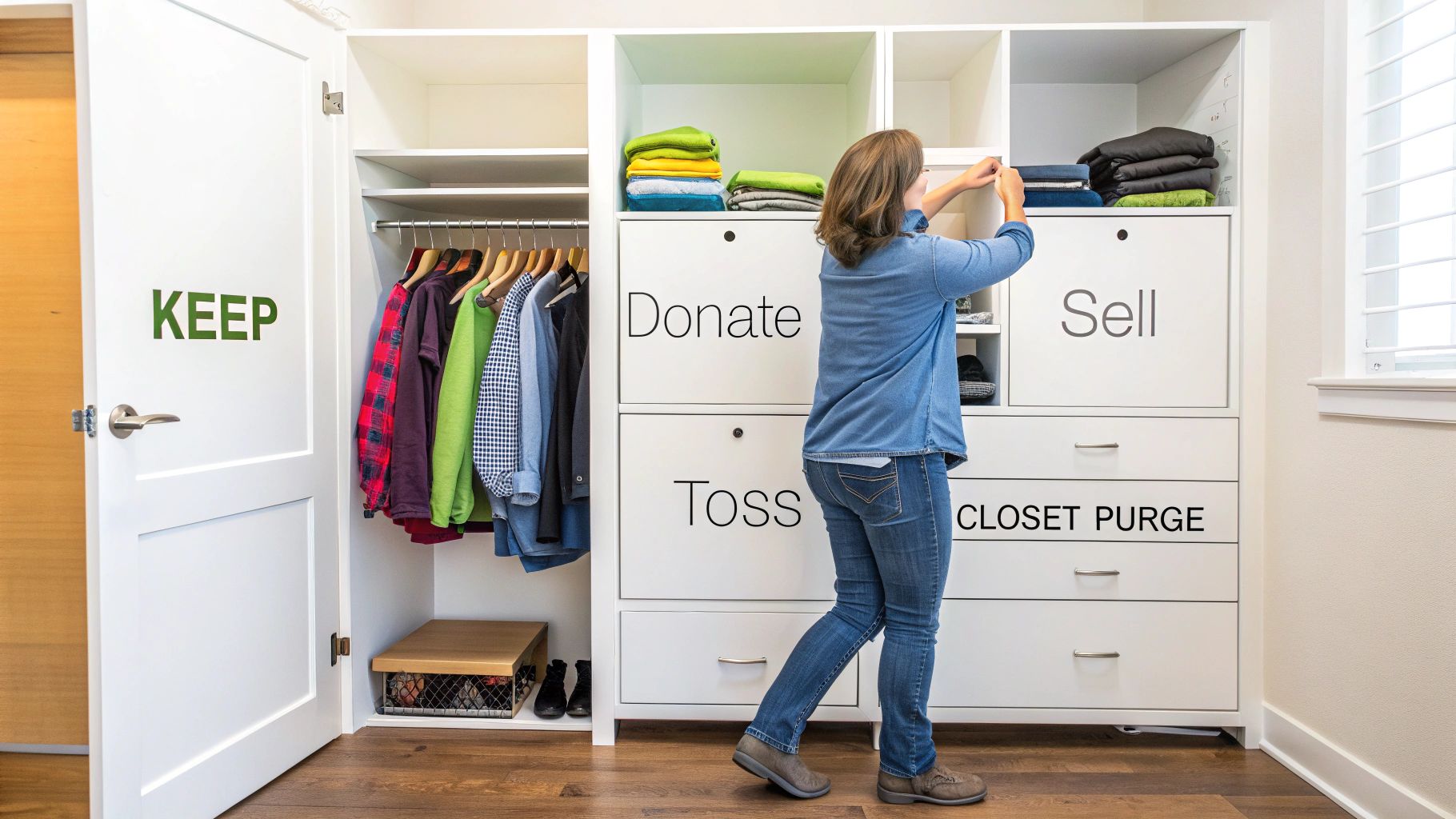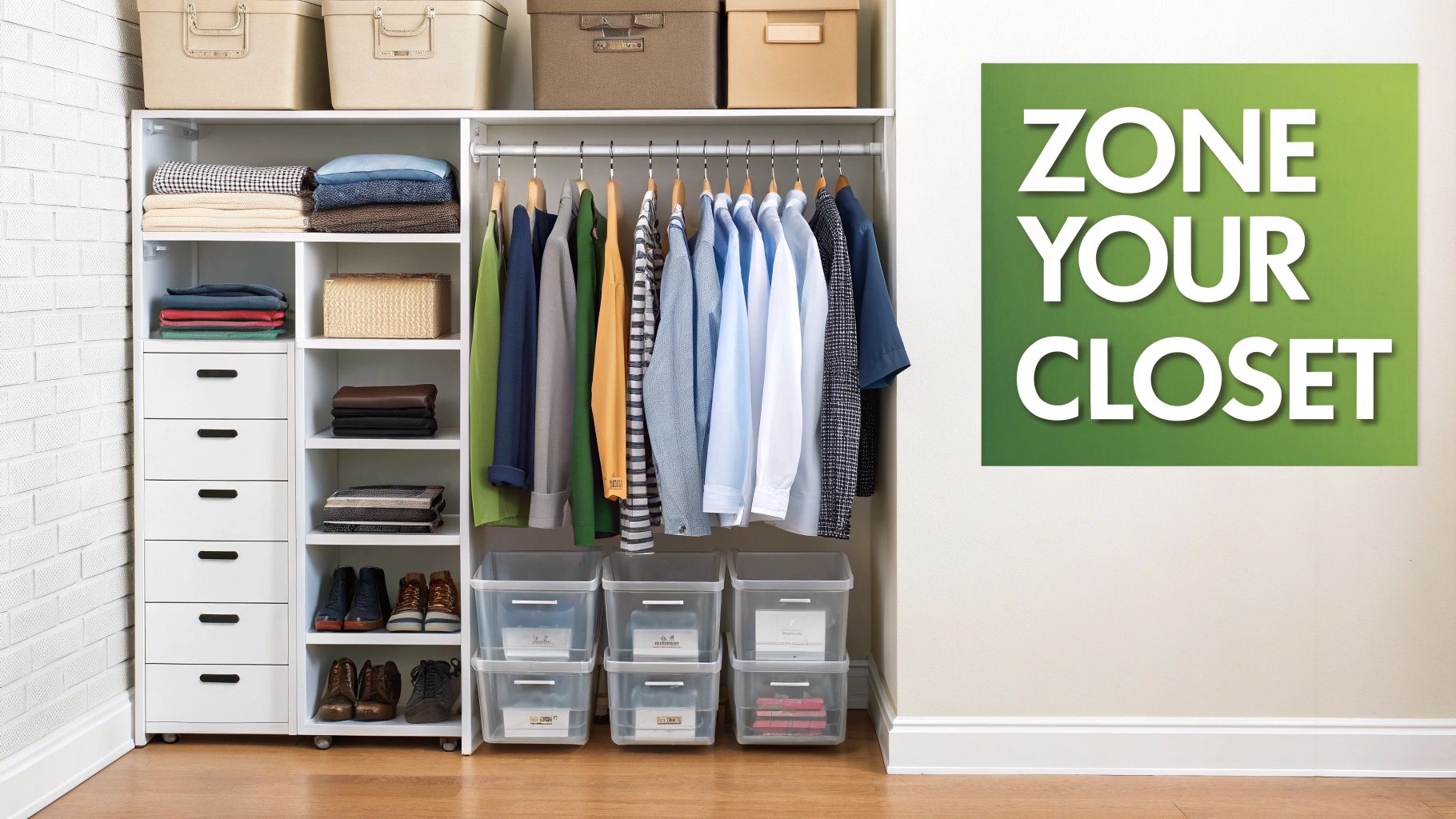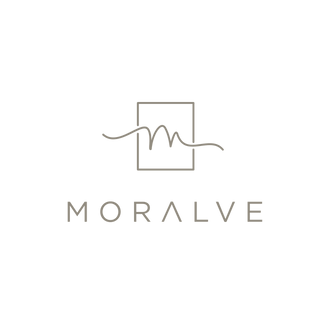Organizing a Closet on a Budget: Easy Tips for Less

The real secret to organizing a closet on a budget isn’t about fancy bins or expensive systems. It starts with a powerful, completely free first step: a ruthless purge. Before you even think about buying a single new hanger, you need to create a clean slate. This ensures you’re only organizing what you truly need, which saves you a ton of time, space, and—most importantly—money.
Step 1: Start with a Smart Closet Purge

It’s tempting to jump straight to the fun part of shopping for cute organizers and dreaming of that perfectly coordinated closet. But trust me, the most effective and budget-friendly move you can make happens before you spend a single dollar. Decluttering is the foundation of good closet organization.
This initial step prevents one of the biggest organizing mistakes: buying storage solutions for things you shouldn't even be keeping. It doesn't make sense to buy a new shoe rack for footwear you haven't touched in years or sweater bins for pullovers that no longer fit. A thorough purge gives you a clear, accurate picture of your actual storage needs.
The Four-Pile Sorting Method
The best way to tackle this without feeling completely overwhelmed is to simplify the process. Grab everything—and I mean everything—out of your closet and create four distinct piles. Be honest and decisive as you sort each item into one of these categories.
- Keep: This is exclusively for clothes you love, wear regularly, and that make you feel fantastic. It should only contain items that fit you right now, not "someday."
- Donate: These are items in good condition that you just don't wear anymore. If something is perfectly fine but no longer your style, let someone else enjoy it.
- Sell: For pieces in great shape or from in-demand brands, consider selling them online or at a local consignment shop. This is a great way to fund your new organizers!
- Toss: This pile is the last resort. Reserve it for items that are stained, torn, or just too worn-out to be useful to anyone else.
Tackling a major declutter can feel like a huge undertaking. Breaking it down into these simple categories turns a chaotic mess into a manageable project. The goal here is progress, not overnight perfection.
Questions to Guide Your Purge
As you handle each piece of clothing, you need a way to fight back against that little voice that says, "But I might wear it someday!" A great place to start is the one-year rule: if you haven't worn an item in the last 12 months, it’s a prime candidate to go.
Beyond that simple rule, ask yourself a few more pointed questions:
- Does this actually fit my current lifestyle? (Not the one I had five years ago.)
- Do I feel genuinely good and comfortable when I wear this?
- If I saw this in a store today, would I buy it again?
By the time you're done, your "keep" pile will represent the wardrobe you actually use and love. For a deeper dive into making these tough calls, you can learn more about how to declutter your closet with our detailed guide. This foundational step is absolutely the key to creating a functional, budget-friendly closet that truly works for you.
Step 2: Find Affordable Organizers Like a Pro
Alright, with the hard part of decluttering behind you, it’s time to hunt for the perfect organizers. Getting your closet in order on a budget is all about being a savvy shopper. You absolutely do not need expensive custom built-ins to create a space that’s both functional and easy on the eyes. It's just a matter of knowing where to look.
The right organization tools do more than just hold your stuff; they make getting ready every day a whole lot easier. Think of it like this: you wouldn't try to build a bookshelf with just a hammer. So why try to organize your closet with a bunch of random, mismatched bins that don’t actually work for you?
Where to Find Budget-Friendly Closet Organizers
Your first move should be to check out places where hidden gems are waiting to be discovered. I'm talking about secondhand spots like Facebook Marketplace and your local thrift stores. These are absolute goldmines for sturdy bins, shelves, and even small drawer units for just a few bucks.
Don't write off big-box retailers and dollar stores, either. Their home goods sections are often packed with simple, effective solutions. Keep an eye out for versatile items like clear stackable bins (so you can see what’s inside at a glance) or basic drawer dividers, which are fantastic for socks, belts, or rolled-up tees. The trick is to walk in with a plan and a shopping list based on the inventory you just took.
Online shopping has also completely changed the game for affordable organizing. In the U.S., for example, over 65% of people tackling a closet project on a budget now buy at least some of their organizers online. They're drawn in by average price drops of 15–25% compared to physical stores. Plus, with online reviews, you can see what other people think. In fact, 70% of buyers say they rely on online ratings before picking up a low-cost organizer. If you're curious, you can dig into the global closet organizer market trends to see how other shoppers are finding deals.
How to Spot a Truly Good Deal
That bright yellow sale sticker doesn't always mean you've found a winner. A "deal" is only a real deal if it solves a problem you actually have. Before you pull out your wallet, ask yourself two things: Is this thing durable enough for what I need it to do? And will it actually fit in my closet?
Pro Tip: Always, always measure your closet shelves, drawers, and floor space before you go shopping. Keep those numbers in your phone. An organizer that’s too big or too small is just more clutter, no matter how cheap it was.
Finally, think about versatility. A simple hanging shelf organizer, for instance, can be a total game-changer. These are some of the best clothes organizers for small spaces because they instantly give you vertical storage for folded sweaters, jeans, or shoes without any drilling or installation. When you focus on multi-functional, well-priced pieces, every dollar you spend becomes a smart investment in your new, streamlined closet.
Step 3: Use Genius DIY Hacks for Maximum Space
Once you’ve scouted for the best deals, it’s time to roll up your sleeves. Why spend a fortune on new organizers when you can craft custom solutions from things you likely already own? Tapping into that DIY spirit is one of the smartest ways to tackle organizing a closet on a budget, turning everyday objects into brilliant storage tools.
This isn’t just about being frugal; it’s about crafting clever, personalized fixes for your specific closet headaches. A little creativity can solve some of the biggest clutter problems.
Double Your Hanging Space Instantly
One of the most common complaints about closet organization is running out of hanging space. Before you install a second rod, try this ridiculously simple, zero-cost trick using a soda can tab.
- Just slip the tab over the neck of a hanger.
- Next, hook a second hanger through the tab’s other hole.
Voilà! You've just cascaded your clothes vertically, instantly doubling your hanging capacity right where you need it most. It's a fantastic method for pairing up outfits or just separating categories like work blouses from casual tops. This tiny hack makes a huge visual and spatial impact without costing a dime.
Repurpose Everyday Items for Smart Storage
Your recycling bin can be a goldmine for organizational supplies. Got some sturdy cardboard boxes lying around? They're perfect for creating custom drawer dividers to finally stop your socks, underwear, and accessories from becoming a tangled mess.
All you have to do is cut cardboard strips to match the height and width of your drawer. Then, slice notches into the middle of each strip so they can interlock to form a grid. Just like that, you have a custom-fit divider system that costs absolutely nothing.
Think of DIY organizing as closet alchemy—transforming common household junk into storage gold. Tension rods, shoeboxes, and even shower curtain rings can all be given new life as incredibly effective organizational tools.
This infographic breaks down the essential steps to sourcing organizers, whether you choose to buy or DIY.

As you can see, organizing your space is a mix of smart shopping and creative thinking. It’s a great reminder that you have plenty of options for finding affordable solutions.
Here's a quick look at some common closet issues and their super-simple DIY fixes.
High-Impact DIY Closet Solutions
| Closet Problem | DIY Solution | Estimated Cost | Time To Implement |
|---|---|---|---|
| Not enough hanging space | Use soda can tabs to cascade hangers vertically | $0 | 5 minutes |
| Tangled scarves and belts | Hang them on a single hanger using shower curtain rings | $0–$5 | 10 minutes |
| Jumbled sock or underwear drawer | Create custom dividers from sturdy cardboard | $0 | 15 minutes |
| Shoe pile on the floor | Use tension rods to create floating shoe shelves | $10–$20 | 10 minutes |
| Messy stack of t-shirts | File-fold t-shirts and store them vertically in shoeboxes | $0 | 20 minutes |
These simple ideas show you don’t need a big budget—or a lot of time—to make a real difference in how your closet functions.
The trend of upcycling and buying secondhand is becoming a major force in home organization. While the entire global home organization market is projected to hit $13.27 billion by 2025, a growing slice of that—around 10–15%—comes from secondhand and repurposed items. Since a used organizer can cost 50–70% less than a new one, this is a game-changing strategy for anyone on a budget.
Step 4: Assemble Your Budget-Friendly Closet System

You've decluttered, you've got your affordable organizers ready, and now it's time for the fun part: bringing your vision to life. This is where you transform that chaotic space into a calm, functional closet that actually works for you. The goal isn't just to cram everything back in, but to build a system that makes your daily routine feel effortless.
We're aiming for maximum visibility and easy access. No more digging through piles or discovering a shirt you forgot you owned six months later. By being strategic now, you’re saving your future self a ton of time and stress.
Create Smart Closet Zones
One of the most effective closet organization tricks is 'zoning.' It sounds fancy, but it just means creating dedicated areas for different types of clothes. Think of your closet like a well-organized store where you know exactly which aisle to find what you need.
Start by grouping similar items together. This naturally creates zones and makes getting dressed a breeze.
- Workwear: Put all your office blouses, trousers, and blazers in one spot. This is a lifesaver on busy weekday mornings.
- Casual & Weekend: Give your t-shirts, jeans, and comfy sweaters their own neighborhood.
- Special Occasion & Seasonal: Formal outfits and bulky winter coats don’t need prime real estate. Store them on a higher shelf or in a less-used corner.
When everything has a designated home, you stop the guesswork. You’ll know instantly where to find something—and more importantly, where to put it back.
Arrange Everything for Easy Access
How you place items within each zone is just as critical as the zones themselves. My rule of thumb is simple: if you can’t see it, you won’t wear it.
One of the best ways to achieve this is with file-folding. Instead of stacking t-shirts, fold them and line them up vertically in a drawer or bin. Stacked shirts mean you only see the one on top; filed shirts let you see every single one at a glance, like files in a cabinet. It’s a total game-changer.
For accessories, clear bins and simple hooks are your new best friends. Using see-through containers for belts or scarves saves you from rummaging through opaque boxes. A few hooks on a bit of empty wall space can keep your most-used bags and scarves perfectly displayed and within reach.
A well-organized closet isn't about having a huge space; it's about making every square inch work smarter for you. Simple changes, like switching to slim velvet hangers, can instantly free up significant rod space and create a clean, uniform look.
Embrace the Power of Modular Solutions
The rise of DIY and modular storage has been a massive win for anyone organizing on a budget. It's no surprise that in markets like North America and Europe, up to 60% of home organizers sold are affordable, easy-to-install products. This trend has exploded on social media, where searches for 'budget closet organization' have jumped by 45% since 2020. People want practical systems they can put together themselves, and the market has responded. For more on this trend, check out the full report on global closet organizers.
This is where your savvy shopping and DIY hacks shine. Hanging shelf units create instant vertical space for sweaters. A simple tension rod can double your hanging space for shirts or shoes. By mixing and matching these elements, you can design a closet system that feels completely custom without the hefty price tag. This final assembly is the most rewarding step, creating a space that’s not just organized, but also perfectly yours.
Step 5: Maintain Your Organized Closet for Good
You’ve put in the work—you decluttered, found some amazing deals, and pieced together your perfect system. So, what’s the biggest challenge now? Keeping it that way. The real secret to a closet that stays organized isn’t a massive, once-a-year cleaning spree. It’s all about building simple, sustainable habits that stop the clutter from ever creeping back in.
Think of it as light, consistent maintenance rather than a heavy-duty repair job. These small routines are what separate a closet that's tidy for a week from one that stays effortlessly organized year-round. The goal is to make these habits so easy they just become part of your routine.
Adopt the One-In, One-Out Rule
If you only adopt one new habit, make it this one: the 'one-in, one-out' rule. It’s incredibly simple but has a massive impact on preventing your closet from getting overstuffed again. Every single time you bring a new item home—a shirt, a pair of jeans, new shoes—something old has to go.
This simple practice forces you to be way more intentional with your shopping. Standing in a store, you'll start asking yourself, "Is this new sweater really worth giving up one I already own?" This little mental check is a game-changer for curbing impulse buys and keeping your closet at a manageable, curated level.
This isn't about restriction; it's about curation. You're treating your closet like a well-curated gallery, where every piece has earned its place. It keeps your wardrobe fresh and prevents it from becoming overstuffed and chaotic again.
Implement a 10-Minute Weekly Reset
Perfection isn't the goal here—consistency is. Just set aside 10 minutes once a week (Sunday evening is a great time) for a quick closet reset. This isn't a deep clean. It's more like a rapid-fire tidy-up to fix any minor messes before they snowball into a huge project.
During your weekly reset, just hit these quick tasks:
- Hang it up: Put away clothes left on a chair or the bed.
- Straighten the stacks: Quickly refold any t-shirt or sweater piles that got messy.
- Tidy the shoes: Line up any pairs that have wandered out of their designated spot.
- Put accessories back: Return any stray belts, scarves, or jewelry to their homes.
This simple routine is your best defense against closet chaos. It’s amazing what just 10 minutes can do to maintain the order you worked so hard to create, keeping your closet a calm, stress-free space.
Master the Seasonal Swap
Finally, handling seasonal clothing is non-negotiable for keeping your closet functional all year. Storing bulky winter coats and chunky sweaters during the summer frees up precious space for the clothes you’re actually wearing right now. And you don't need a fancy storage unit for this.
A few inexpensive vacuum-sealed bags work wonders for compressing puffy jackets and thick knits, letting you slide them easily under a bed or on a high shelf. Simple under-bed bins are also perfect for stashing off-season shoes, shorts, or swimwear. By doing a quick wardrobe rotation twice a year, you ensure your closet always feels relevant, spacious, and way easier to navigate.
Your Closet Organization Questions Answered
Even the most straightforward closet project can throw you a curveball. Let's tackle some of the most common questions that pop up when you're trying to get organized on a budget, so you can move past any roadblocks and finally create a closet you love.
How Can I Add More Space to a Tiny Closet?
When your closet is bursting at the seams, the only direction to go is up. Thinking vertically is the secret weapon for making a small closet work harder. The single best thing you can do right now is switch to slim hangers. This one change can give you back almost 50% of your rod space.
Once you’ve done that, keep looking for that unused vertical real estate:
- Hanging shelf organizers are a lifesaver. They instantly turn that empty space under your short-hanging clothes into neat shelves for sweaters, t-shirts, and jeans.
- The back of the door is prime, often-forgotten territory. An over-the-door organizer is a total workhorse for shoes, scarves, belts—all those little things that create chaos elsewhere.
You have to retrain your eye to see the empty air in your closet as a storage opportunity. Once you start thinking that way, you’ll find hidden space everywhere.
Where Should I Spend My Limited Budget First?
If you only have a little cash to work with, put it where you'll get the most bang for your buck. Your absolute first priority should be a matching set of slim hangers. It's the cheapest upgrade you can make, but the visual and spatial payoff is enormous. A closet full of uniform hangers immediately looks calmer and more put-together.
After that, your next best move is getting some simple bins or drawer dividers. You don’t need anything fancy. The dollar store is your best friend here. Even better? Make your own dividers from sturdy cardboard boxes you have lying around—a completely free solution that works just as well.
Key Takeaway: Start with the small things that make a big difference. Matching hangers and basic containers are the foundation of a well-organized closet and won't break the bank.
How Do I Decide What to Get Rid Of?
This is where it gets tough. The key is to be brutally honest with yourself. To take the emotion out of it, use a simple three-question test for every item you’re on the fence about:
- Have I worn this in the last 12 months?
- Does it fit my body right now (not the body I hope to have one day)?
- Do I actually feel good and confident when I put this on?
If you get a "no" on any of these, it's time for that piece to find a new home. Don't fall into the "someday" trap. Your closet's job is to serve the person you are today.
Ready to build a closet that feels spacious and finally works for you? The right tools make all the difference. Explore space-saving hangers and other smart solutions from MORALVE to start your journey to an effortlessly organized closet. Find your perfect fit at https://moralve.com.


Leave a comment